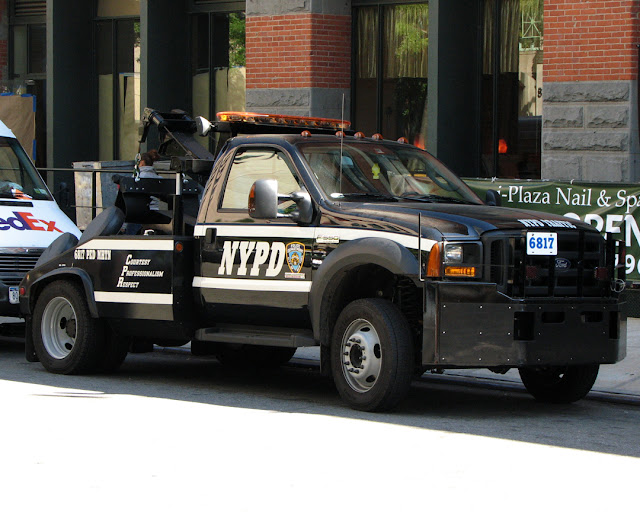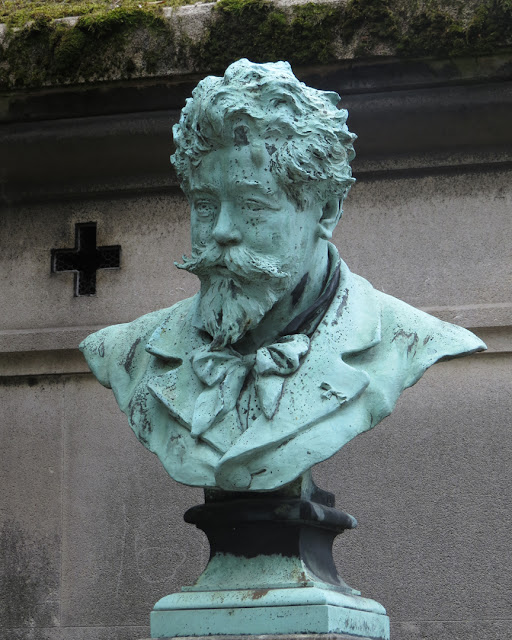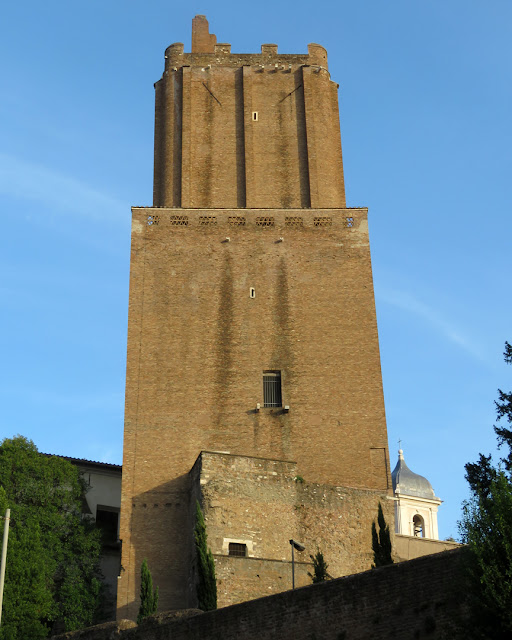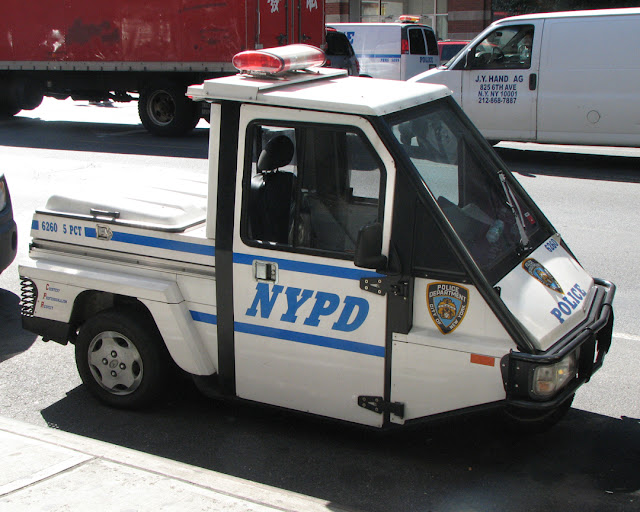Thursday, April 30, 2020
Gothic Tabernacle
Gothic Tabernacle by Andrea Orcagna, 1359
Madonna and Child by Bernardo Daddi, 1335
Church of Orsanmichele
Via dell'Arte della Lana
Florence, January 2019
“The tabernacle in Orsanmichele (finished 1359) which was regarded as ‘the most perfect work of its kind in Italian Gothic’.” (Orcagna, Wikipedia)
Wednesday, April 29, 2020
Tuesday, April 28, 2020
Aristide Vigneron
Grave of Aristide Vigneron (1846-1903)
Cimetière du Père-Lachaise, (Père Lachaise Cemetery)
Quartier du Père-Lachaise, 20th arrondissement
Paris, July 2014
Monday, April 27, 2020
Side colonnade
Side colonnade of the Temple of Hadrian
Piazza di Pietra
Rome, September 2019
“The Temple of Hadrian (Templum Divus Hadrianus, also Hadrianeum) was dedicated to the deified emperor Hadrian on the Campus Martius in Rome, Italy by his adoptive son and successor Antoninus Pius in 145 C.E. This temple was previously known as the Basilica of Neptune but has since been properly attributed as the Temple of Hadrian completed under Antoninus Pius. With one cella wall and eleven columns from the external colonnade surviving, the remains of the temple have been incorporated into a later building in the Piazza di Pietra (Piazza of Stone – derived from use of the temple's stones to build the piazza), whereby its facade, alongside the architrave which was reconstructed later on, was incorporated into a 17th-century papal palace by Carlo Fontana, now occupied by Rome's Chamber of commerce. While only part of the structure remains, excavations and scholarship have provided us with information regarding its construction techniques and stylistic influences, helping us recreate the building dynamics and significance of the Temple of Hadrian in Imperial Rome.” (Temple of Hadrian, Wikipedia)
Sunday, April 26, 2020
Diário de Notícias
Monument to Eduardo Coelho, founder of the Diário de Notícias, by Costa Motta (tio), 1904
Jardim António Nobre
Miradouro de São Pedro de Alcântara
Bairro Alto
Lisbon, April 2019
“Diário de Notícias is a Portuguese daily newspaper published in Lisbon, Portugal. Diário de Notícias was first published in Lisbon on 29 December 1864 by Tomás Quintino Antunes and Eduardo Coelho. At its early phase the paper had no explicit political stance and financially relied on the advertisements. Its headquarters is in Lisbon. During the 1880s the novelist Eça de Queiroz, then stationed in Newcastle-upon-Tyne, England in the Portuguese diplomatic service, contributed occasional ‘London letters’ to the newspaper. Some of these were afterwards published in a book entitled Cartas de Inglaterra. Before the Carnation revolution Diário de Notícias belonged to the Empresa Nacional de Publicidade a propaganda arm of the dictatorship. Following the Carnation revolution, the paper remained nationalized until the early 1990s. Then the paper and Jornal de Notícias were sold to the Lusomundo group. In 2005 the Controlinveste group bought papers. Both papers are now owned by Angolan media conglomerate Global Media Group (formerly Controlinveste Media). Diário de Notícias is published in tabloid format. Music critic Joaquim Seabra Pessoa, father of poet Fernando Pessoa, worked for the paper. In 2018 Diário de Notícias became a weekly newspaper published on Saturdays.” (Diário de Notícias, Wikipedia)
Saturday, April 25, 2020
“Gdańsk”
Three-dimensional “Gdańsk” letters, 2007
Parking lot of the Baltic Philharmonic
Ołowianka
Gdańsk, September 2018
Friday, April 24, 2020
Badia Fiorentina
The bell tower of the Badia Fiorentina
Seen from a window of Palazzo Vecchio
Florence, January 2019
“The abbey was founded as a Benedictine institution in 978 by Willa, Countess of Tuscany, in commemoration of her late husband Hubert, and was one of the chief buildings of medieval Florence. A hospital was founded in the abbey in 1071. The church bell marked the main divisions of the Florentine day. Between 1284 and 1310 the Romanesque church was rebuilt in Gothic style, but in 1307 part of the church was demolished to punish the monks for non-payment of taxes. The church underwent a Baroque transformation between 1627 and 1631. The prominent campanile, completed between 1310 and 1330, is Romanesque at its base and Gothic in its upper stages. Its construction was overseen by the famous chronicler Giovanni Villani.” (Badia Fiorentina, Wikipedia)
Thursday, April 23, 2020
Confucius
Statue of Confucius by Liu Shih
Confucius Plaza
New York, September 2007
“One of the most frequently visited landmarks in Chinatown is the 15-foot bronze statue of Confucius, the Chinese philosopher, in front of the complex. Sculpted by Liu Shih, the statue was presented by the Chinese Consolidated Benevolent Association as a token of appreciation, and to commemorate the U.S. bicentennial. At its base, a Confucian proverb is inscribed aside an American Flag, praising a just government with remarkable leaders of wisdom and ability.” (Confucius Plaza, Wikipedia)
Wednesday, April 22, 2020
Syrenka Warszawska
Syrenka Warszawska (Mermaid of Warsaw) by Konstanty Hegel
Rynek Starego Miasta (Old Town Market Place)
Stare Miasto (Old Town)
Warsaw, September 2018
“The sculpture in Warsaw's Old Town Square was designed by Varsovian sculptor Konstanty Hegel. Originally (1855–1928) and now (since 2000) it stands in the marketplace. At other times, it was moved to different places in Warsaw. In 2008, the original sculpture made of bronzed zinc was taken from the market for maintenance work. The sculpture was in a very poor condition due to mechanical damage and numerous acts of vandalism. The repaired original was transferred to the Museum of Warsaw, and replaced with a copy of made by the Jacek Guzera foundry in Dąbrowie near Kielce.” (Mermaid of Warsaw, Wikipedia)
Tuesday, April 21, 2020
Torre delle Milizie
Torre delle Milizie
Salita del Grillo
Rome, September 2019
“The Torre delle Milizie (Tower of the Militia) is a fortified tower in Rome, Italy, located between Trajan's Market in the Imperial fora to the southwest and the Pontifical University of Saint Thomas Aquinas, or Angelicum, to the east. It gained the popular nickname of ‘Nero's Tower’ from a tradition that it originated as an ancient Roman construction from which Emperor Nero watched the Great Fire of Rome – this is derived from the classical account that he watched from a tower in the Gardens of Maecenas, though more trustworthy accounts place him out of town, at Antium at the time. The actual construction of the tower probably dates to the time of Pope Innocent III (1198–1216) under the Aretino family. At the end of the 13th century, the tower was a possession of the powerful Annibaldi family, who were followed by the Prefetti di Vico and by the Caetani, Pope Boniface VIII's family. Under the Caetani the fortified quarter was enlarged and strengthened, probably rivalling with Castel Sant'Angelo as Rome's main fortress.” (Torre delle Milizie, Wikipedia)
Monday, April 20, 2020
Sunday, April 19, 2020
Saturday, April 18, 2020
David by Donatello
The bronze “David” by Donatello, 1440s
Museo Nazionale del Bargello
Florence, January 2019
“Donatello's bronze statue of David (circa 1440s) is famous as the first unsupported standing work of bronze cast during the Renaissance, and the first freestanding nude male sculpture made since antiquity. It depicts David with an enigmatic smile, posed with his foot on Goliath's severed head just after defeating the giant. The youth is completely naked, apart from a laurel-topped hat and boots, and bears the sword of Goliath. The creation of the work is entirely undocumented. Most scholars assume the statue was commissioned by Cosimo de' Medici, but the date of its creation is unknown and widely disputed; suggested dates vary from the 1420s to the 1460s (Donatello died in 1466), with the majority opinion recently falling in the 1440s, when the new Medici Palace designed by Michelozzo was under construction. According to one theory, it was commissioned by the Medici family in the 1430s to be placed in the center of the courtyard of the old Medici Palace.” (David by Donatello, Wikipedia)
Friday, April 17, 2020
Thursday, April 16, 2020
Oscar Wilde's tomb
Oscar Wilde's tomb (1851-1900) by Jacob Epstein, 1914
Cimetière du Père-Lachaise, (Père Lachaise Cemetery)
Quartier du Père-Lachaise, 20th arrondissement
Paris, July 2014
“The tomb of Oscar Wilde is located in Père Lachaise Cemetery, Paris, France. It took nine to ten months to complete by the sculptor Jacob Epstein, with an accompanying plinth by Charles Holden and an inscription carved by Joseph Cribb. In 1908, Oscar Wilde's literary executor Robert Ross chose Jacob Epstein for the commission of the tomb at a cost of two thousand pounds, which had been anonymously donated for this purpose. Later, in a publication of letters between Ada Leverson and Ross in 1930, Letters to the Sphinx, the anonymous donor was revealed to be Helen Carew, with financial assistance from novelist Stephen Hudson (Sydney Schiff). This was only Epstein's second commission, his first being the sculpture for the Holden-designed British Medical Association building in The Strand; these had been severely criticised for being too sexualised for public consumption. However, Epstein retained some noteworthy supporters within the Wilde circle such as William Rothenstein.” (Oscar Wilde's tomb, Wikipedia)
Wednesday, April 15, 2020
Pasquino
Pasquino
Piazza Pasquino
Rome, September 2019
“Pasquino or Pasquin (Latin: Pasquillus) is the name used by Romans since the early modern period to describe a battered Hellenistic-style statue perhaps dating to the third century BC, which was unearthed in the Parione district of Rome in the fifteenth century. It is located in a piazza of the same name on the southwest corner of the Palazzo Braschi (Museo di Roma); near the site where it was unearthed. The statue is known as the first of the talking statues of Rome, because of the tradition of attaching anonymous criticisms to its base. The satirical literary form pasquinade (or ‘pasquil’) takes its name from this tradition. The actual subject of the sculpture is Menelaus supporting the body of Patroclus, and the subject, or the composition applied to other figures as in the Sperlonga sculptures, occurs a number of times in classical sculpture, where it is now known as a ‘Pasquino group’. The actual identification of the sculptural subject was made in the eighteenth century by the antiquarian Ennio Quirino Visconti, who identified it as the torso of Menelaus supporting the dying Patroclus; the more famous of two Medici versions of this is in the Loggia dei Lanzi in Florence, Italy. The Pasquino is more recently characterized as a Hellenistic sculpture of the third century BC, or a Roman copy.” (Pasquino, Wikipedia)
Tuesday, April 14, 2020
Monday, April 13, 2020
Sunday, April 12, 2020
Galileo Galilei
Statue of Galileo Galilei by Bernardo Morescalchi, 1932
Facade of the Biblioteca Nazionale Centrale (Central National Library)
Piazza dei Cavalleggeri
Florence, January 2019
Saturday, April 11, 2020
Ventilation Building
Brooklyn-Battery Tunnel Ventilation Building
Governors Island
New York, September 2007
“The Brooklyn–Battery Tunnel has a total of four ventilation buildings: two in Manhattan, one in Brooklyn, and one on Governors Island. One of the Manhattan ventilation buildings is granite-faced and designed like a monument, due to objections to the building's design during the construction process. The Manhattan ventilation structure was depicted as the men in black's headquarters in the Men in Black movie franchise. The Governors Island ventilation structure, designed by McKim, Mead & White, is an octagonal building located over the midpoint of the tunnel's route, at its lowest point. According to the MTA, the ventilation buildings can completely replace the tunnel's air every ninety seconds. During construction, tunnel engineers touted the ventilation system as being so efficient that the ventilation towers could blow 25,000 tons of clean air into the tunnel every hour. The system consists of 53 fans that each had a diameter of 8 feet (2.4 m).” (Brooklyn–Battery Tunnel, Wikipedia)
Friday, April 10, 2020
Wedding photo
Wedding photo
Sant Pere de les Puelles
Plaça de Sant Pere
Barcelona, March 2017
“Sant Pere de les Puelles (in Catalan, Puel·les, in Spanish, Real Monasterio de San Pedro de las Puellas) is a Benedictine monastery in the Sant Pere, Santa Caterina i la Ribera neighborhood of the Ciutat Vella district of Barcelona, Catalonia, Spain. The 10th-century building, Romanesque/Gothic in style, was declared a Bien de Interés Cultural landmark in 1931.” (Sant Pere de les Puelles, Wikipedia)
Thursday, April 9, 2020
San Giovanni della Pigna
San Giovanni della Pigna
Traversa Vicolo della Minerva
Rome, September 2019
“San Giovanni della Pigna (Saint John of the Pine Cone) is a small Roman Catholic church located on Traversa Vicolo della Minerva 51 in the rione Pigna of Rome, Italy. The church was made a cardinalate deaconry by Pope John Paul II in 1985. Initially a church dedicated to Saints Eleuterio and Ginnasi Martyrs was located here. In ruinous state, it was granted by Pope Gregory XIII to the Archconfraternity of the ‘Pietà verso li carcerati’, led by the Jesuit Giovanni Talier. The lay organization made outreach to prisoners, including galley prisoners. Pope Sixtus V granted them the right to pardon one prisoner under the death sentence. In 1624, the church was refurbished under the designs of Angelo Torroni. The main altarpiece depicts St John the Baptist by Baldassare Croce; a Pieta by Luigi Garzi; and a St Eleuterio by Giacomo Zoboli.” (San Giovanni della Pigna, Wikipedia)
Wednesday, April 8, 2020
Tuesday, April 7, 2020
Monday, April 6, 2020
Dante Alighieri
Statue of Dante Alighieri by Bernardo Morescalchi, 1932
Facade of the Biblioteca Nazionale Centrale (Central National Library)
Piazza dei Cavalleggeri
Florence, January 2019
Sunday, April 5, 2020
South Ferry
Staten Island Ferry Whitehall Terminal
Battery Maritime Building
South Ferry, Lower Manhattan
New York, September 2007
“South Ferry is at the southern tip of Manhattan in New York City and is the embarkation point for ferries to Staten Island (Staten Island Ferry, through the Staten Island Ferry Whitehall Terminal) and Governors Island. Battery Park, abutting South Ferry on the west, has docking areas for ferries to Liberty Island and Ellis Island. Its name is derived from an historical ferry company which provided service to Brooklyn, run by the South Ferry Company.” (South Ferry, Wikipedia)
Saturday, April 4, 2020
Pałac Prezydencki
Pałac Prezydencki (Presidential Palace)
Statue of Prince Józef Poniatowski by Bertel Thorvaldsen
Krakowskie Przedmieście
Warsaw, September 2018
“The Presidential Palace (Polish: Pałac Prezydencki) is the official residence of the Polish head of state and president alongside the Belweder Palace, located in Warsaw, Poland. Originally constructed in 1643 as an aristocratic mansion, it was rebuilt and remodelled several times over the course of its existence by notable architects. The current neoclassical palace was completed in 1818. Throughout its history, the palace was a venue for important historical events in Polish, European, and world history. In 1791, the facility hosted authors and advocates of the Constitution of May 3, 1791, the first modern European constitution. In 1818, the palace began its ongoing career as a governmental structure when it became the seat of the Viceroy (namiestnik) of Congress Poland. Following Poland's resurrection after World War I, in 1918, the building was taken over by the newly reconstituted Polish authorities and became the seat of the Council of Ministers. During World War II, it served as a Deutsches Haus for the country's German occupiers and survived the 1944 Warsaw Uprising intact. After the war, it resumed its function as seat of the Polish Council of Ministers. On 14 May 1955, the Warsaw Pact was signed inside the Presidential Palace between the Soviet Union and the Eastern Bloc countries. Since July 1994, the palace has been the official seat of the President of the Republic of Poland.” (Presidential Palace, Wikipedia)
Friday, April 3, 2020
Thursday, April 2, 2020
Estufa Fria
Estufa Fria
Eduardo VII Park
Lisbon, April 2019
“The Estufa Fria is a greenhouse with three gardens located in Eduardo VII Park, between Alameda Engenheiro Edgar Cardoso and Alameda Cardeal Cerejeira in Lisbon, Portugal. With an area of about 1.5 hectares, it consists of three parts, the Cold Greenhouse proper, Glasshouse Hot and Sweet Greenhouse. The cold area, the largest of the three with about 8100 square meters, is covered with a lath of wood that naturally control the temperature and light inside. Alberga species such as azalea (rhododendron spp.) and camellias (Camellia japonica) from various parts of the world. The area of the Estufa Quente occupies about 3000 square meters and is home to such tropical climate species as coffee ( coffea sp.) and mangifera. The Estufa Doce has species of cacti, and other succulent plants, such as aloe (Aloe vera). The whole greenhouse features small lakes, waterfalls and statues.” (Estufa Fria, Wikipedia)
Wednesday, April 1, 2020
Subscribe to:
Posts (Atom)






























